In post “Access Control Policies and Issuance Authorization Rules in ADFS 4.0 – Part 1” we took a quick look on Access Control Policies in ADFS 4.0. We learnt that those can be a very helpful tool to grant permissions for using a Relying Party Trust.
However, in case of our request example, using Claim Rule Language together with Issuance Authorization Rules will meet the request straightforward while we would see difficulties when relying on Access Control Policies.
Here is the definition of our example:
Use Case Example:
All users who are member of any security group starting with CLOUD_ should get access to the Relying Party Trust (and get authorization for the Cloud application). If they are also member of any group starting with DE_, they should get a denial for that Relying Party Trust. Additionally, access is limited only to users who connect from inside the corporate network
Using Control Access Policies to create special access conditions where group membership based on a filter is the key to allow or deny access turns out to be difficult. In the Control Access Policy template, you can only choose specific groups from an Active Directory object picker, which is too static in our case where new security groups might be created and deleted again.

Therefore, we use the advantage that ADFS 4.0 supports both, Access Control Policies and Issue Authorization Rules in the same farm.
How to get into the Issue Authorization Rules configuration item
When you create a new Relying Party Trust (RPT), you will noticed, that the wizard sets the “Permit everyone” Access Control Policy for your trust, but offers also to select from the list of templates and existing ones. A checkbox at the bottom gives you the option to skip the configuration of an Access Control Policy at the time of trust creation.
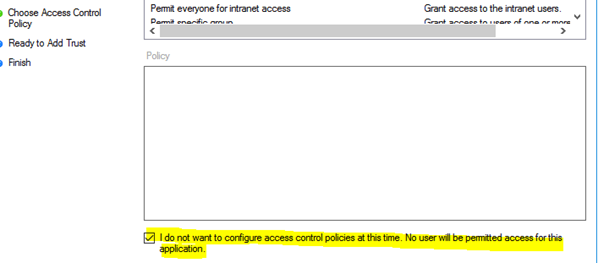
Right-clicking the Relying Party Trust after creation without setting an Access Control Policy still brings us to the well-known Access Control Policy selection.

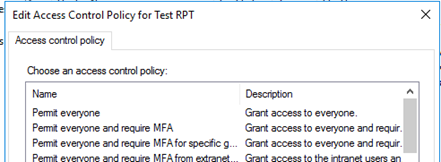
In order to switch from Access Control Policy to the Issuance Authorization Rules menu we need to use the related Powershell Commandlet.
- We set a dummy policy as Access Control Policy (which does not do any harm because conditions are never met for access).
- We remove this Access Control Policy by setting $null.

Going back to the menu and right-clicking on the trust and selecting “Edit Access Control Policy …” will bring us a menu where we can define Issuance Authorization Rules, as we know from ADFS 3.0. Please note, that the Access Control Policy, which was cleared by our Powershell command No.2, has become a second life as Issuance Authorization Rule!

The same is visible when retrieving the related attributes by using the Get-AdfsRelyingPartyTrust commandlet.

 |
You will always have to use the Powershell Commandlet Set-AdfsRelyingPartyTrust if you want to clear an existing Access Control Policy from a Relying Party Trust. The GUI will only allow replacing policies. |
Creating and placing the appropriate Issuance Authorization Rules
Once we know that we can place the rules as we know from ADFS 3.0, we can start to configure the conditions. Since we have to deal with the condition to be member of one or multiple groups that start with prefix “CLOUD_” and to be not a member of at least one group starting with prefix “DE_” at the same time, we will have to build two rules – one with an “add” statement and one with an “issue” statement.
The first rule will retrieve all the group names where the user is member and passes this information further to the second rule. This step is necessary because by default only the groups’ SIDs are part of the claim.
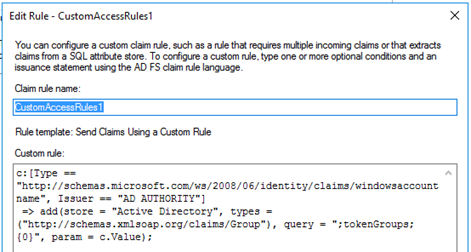
The second rule will then check for the permit group conditions (“name starts with CLOUD_”) and the deny group condition (“name starts with DE_”). Additionally, the rule checks for the presence of the “insidecorporatenetwork” claim, which exists whenever the user does not connect through public interfaces and works as incoming claim.
If there is no membership in a deny group, but membership in a permit group, and the user connects from the internal network, thus the rule will issue an authentication token (claim) finally.
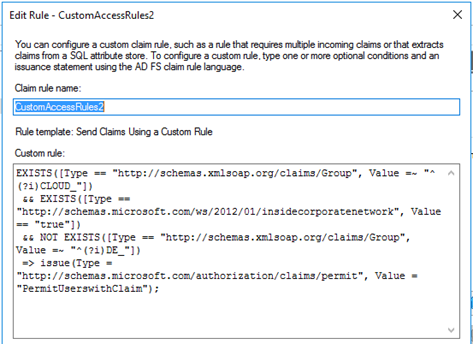
Testing the Rule
When writing custom Issuance Authorization Rules, testing is key. If you plan to protect your production Relying Party Trust by complex access rules, you cannot go live with those without proper testing. There are several test applications around which make the outgoing claims visible and therefore easy to check.
Just assign the rules to the Relying Party Trust of the application and see if a test user can access or not (which implies a permit or deny of authentication though).
As you can see, from the screenshot below, our test user is member of two groups, that starts with “CLOUD_” in their names and he is obviously not member of a “DE_” group. We can also see that the “insidecorporatenetwork” claim is set to true which was another condition.
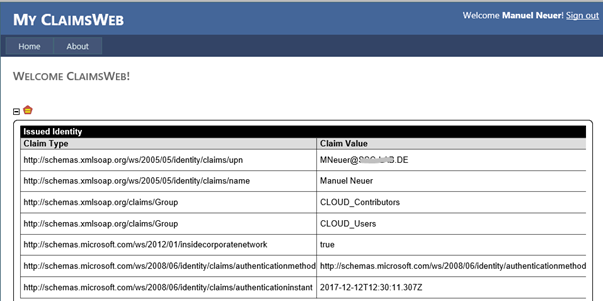
The fact that we can see the test application web site at all is the evidence that the user was authorized to use the Relying Party Trust and connect to the application. Mission accomplished without using Access Control Policies.
 |
Microsoft has published a web based ADFS test application, which is called Claims X-Ray and works perfectly by mirroring the incoming claims. You can find it here https://adfshelp.microsoft.com/Tools/ShowToolsInternal and external devices can access it, which makes it a very valuable troubleshooting tool. |





















